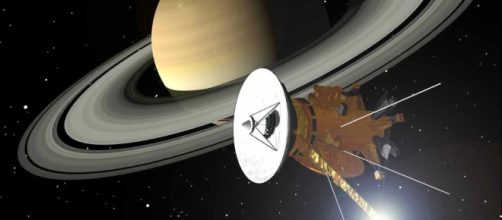Cassini spacecraft, which is nearing the end of its life, is zigzagging between the rings of the planet getting closer and closer to Saturn. The spacecraft has just sent some incredible pictures of the ringed planet in the process.
The veteran craft has completed 50 percent of its final phase which consists of about 20 orbits including some grazing the outer edge of the main ring system. The last phase started last November and will continue till September.
Cassini is now traveling at an incredible speed of 77,000 miles per hour. The spacecraft is traveling in great peril and is using its antenna as a shield to protect itself from any particle in the rings which could punch a hole into its body when traveling at such high speeds.
Last weekend the craft conducted a flyby of the Titan. The craft will be deliberately sent crashing into the Saturn’s atmosphere to pre-empt any possibility of accidental contamination on Saturn’s potentially life-harboring moons.
A hauntingly beautiful crescent #Saturn with a sliver of its rings. Taken by #Cassini Apr 29 2017. pic.twitter.com/w02g6O9xs5
— Sophia Nasr (@Pharaoness) April 30, 2017
Cassini survives
According to latest reports, Cassini has survived the initial plunge between the rings of Saturn. There was a brief disruption of communication during the fly by, but the craft has started communicating with mission control now. Cassini was blasted off for its long journey in October 1997 and arrived at Saturn in July 2004.
The end of the mission is set for September 15, 2017.
The craft is skimming closer and closer to the sixth planet from the sun than any other previous rendezvous by a spacecraft in the past. Much of the close encounters of the spacecraft which is moving between the rings are based on experience with the other rings of the planet. At present, the craft is 3000 km from the cloud tops of the planet and 300 km from its inner rings.
Cassini in space
The spacecraft is moving in a gap which is about 2,400 kilometers wide in between the rings and the outer fringes of the planet’s atmosphere. The rings are composed up of ice and space debris and are reportedly traveling at incredible speeds.
In our current orbit, we’ll roll to calibrate our magnetometer for high-intensity magnetic field scans, another first. #SaturnSaturday pic.twitter.com/WstLhxcTf7
— CassiniSaturn (@CassiniSaturn) April 29, 2017
The grand finale which is scheduled for September when the craft makes its final plunge into the planet’s atmosphere will not be a silent hara-kiri, but the instruments will continue to transmit data which will further enrich our knowledge of the outer members of the solar system.
The risks of the final mission are enormous, and the Cassini team knows this too well. However, the risks are worth taking when compared to the benefits which can be reaped.

